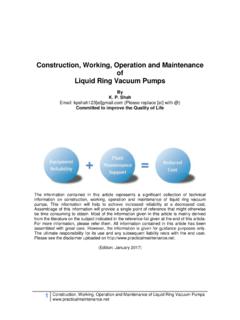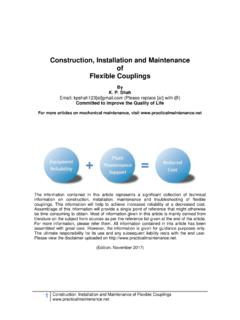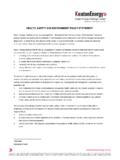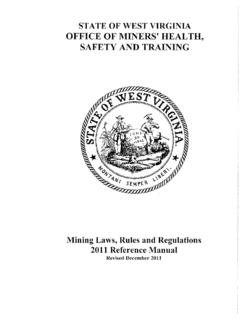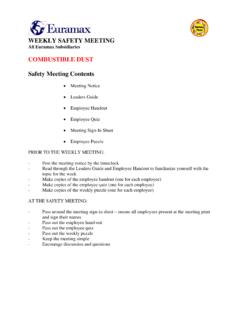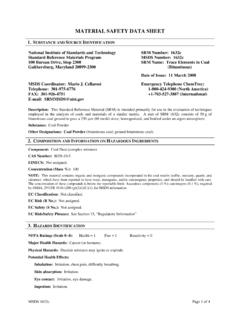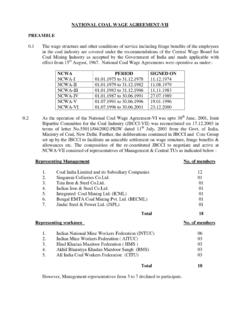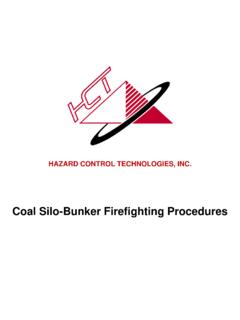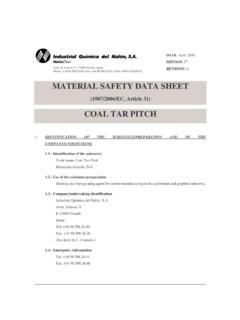Transcription of Spontaneous Combustion of Coal - Practical …
1 Spontaneous Combustion of Coal By K. P. Shah Email: kpshah123[at] (Please replace [at] with Committed to improve the Quality of Life For more articles on mechanical maintenance, visit The information contained in this article represents a significant collection of technical information about Spontaneous Combustion of coal and care to be taken for their use in a power plant. This information will be also useful for coal storage and coal transportation. This information will help to minimize accidents and achieve increased reliability at a decreased cost. Assemblage of this information will provide a single point of reference that might otherwise be time consuming to obtain. Most of information given in this article is mainly derived from literature on the subject from sources as per the reference list given at the end of this article.)
2 For more information, please refer them. All information contained in this article has been assembled with great care. However, the information is given for guidance purposes only. The ultimate responsibility for its use and any subsequent liability rests with the end user. Please view the disclaimer uploaded on (Edition: November 2017). 1 Spontaneous Combustion of coal Spontaneous Combustion of Coal To reduce sulfur emissions or non-availability of traditional coal, there has been a shift in recent years from use of more traditional bituminous coal to subbituminous coal, such as Powder River Basin (PRB) coal and Indonesian coal like ENVIROCOAL by PT Adaro, Indonesia. These coals tend to react with oxygen in the air and have tendency for Spontaneous Combustion . This has resulted in fires at facilities that previously had excellent safety records.
3 Operators familiar with the unique requirements of burning PRB coal will tell you that it's not a case of "if" you will have a PRB coal fire, it's "when.". Spontaneous Combustion of coal is the process of self heating resulting eventually in its ignition without the application of external heat. It is caused by the oxidation of coal. If the rate of dissipation of heat is slow with respect to the evolution of heat by oxidation there will be a gradual buildup of heat and temperature will reach the ignition point of coal thereby causing fire or explosion. Normally, if the supply of oxygen is stopped or used up, as in the middle of a stockpile, the temperature will then decrease, stabilize and self heating will not proceed further. In view of above, important information on Spontaneous Combustion of coal and care to be taken for their use in a power plant is given in this article.
4 The information will be useful for coal storage and coal transportation also. Coal Rank The degree of change undergone by a coal as it matures from peat to anthracite - a process known as coalification - has an important bearing on its physical and chemical properties and is referred to as the rank of the coal. Coal is classified into four general ranks/categories. They are lignite, subbituminous, bituminous and anthracite. Low-rank coals, such as lignite and subbituminous coals are typically softer, friable materials with a dull, earthy appearance. They are characterized by high moisture levels and low carbon content and, therefore, low energy content. High-rank coals are generally harder and stronger and often have a black vitreous luster. They contain more carbon, have lower moisture content, and produce more energy.
5 Anthracite coal with the highest carbon content, between 86% and 98% is having a heat value of nearly 15,000 Btu/lb ( MJ/kg). Bituminous coal has a carbon content ranging from 45% to 86% and is having a heat value of 10,500 to 15,500 Btu/lb ( to 36 MJ/kg). Subbituminous coal with 35 to 45% carbon content is having a heat value between 8,300. and 13,000 Btu/lb ( and MJ/kg). Lignite having the lowest carbon content, between 25 and 35% is having a heat value ranging between 4000 and 8300 Btu/lb ( and MJ/kg). American Society for Testing and Materials (ASTM) standard D 388 - 98 classifies coals by rank, that is, according to their progressive alteration, in the natural series from lignite to anthracite. The higher rank coals are classified according to fixed carbon on the dry basis; the lower rank coals are classified according to gross calorific value on the moist basis.
6 Various classes as per the standard, in order of rank are: anthracitic (highest rank), bituminous, subbituminous and lignitic (lowest rank). Each class contains number of groups as under. 2 Spontaneous Combustion of coal Class Group Anthracitic Meta-anthracite Anthracite Semianthracite Bituminous Low volatile bituminous coal Medium volatile bituminous coal High volatile A bituminous coal High volatile B bituminous coal High volatile C bituminous coal Subbituminous Subbituminous A coal Subbituminous B coal Subbituminous C coal Lignitic Lignite A. Lignite B. Rank is assessed by a series of tests, collectively called the proximate analysis, that determine the moisture content, volatile matter content, ash content, fixed carbon content, and calorific value of a coal. Moisture Content Moisture content is determined by heating an air dried coal sample at 105-110 C (221- 230 F) under specified conditions until a constant weight is obtained.
7 In general, the moisture content increases with decreasing rank and ranges from 1 to 40 percent for the various ranks of coal. The presence of moisture is an important factor in both the storage and the utilization of coals, as it adds unnecessary weight during transportation, reduces the calorific value, and poses some handling problems. Volatile Matter Content Volatile matter is material that is driven off when coal is heated to 950 C (1742 F) in the absence of air under specified conditions. It is measured practically by determining the loss of weight. Consisting of a mixture of gases, low-boiling-point organic compounds that condense into oils upon cooling, and tars, volatile matter increases with decreasing rank. In general, coals with high volatile-matter content ignite easily and are highly reactive in Combustion applications.
8 Mineral (Ash) Content Coal contains a variety of minerals in varying proportions that, when the coal is burned, are transformed into ash. The amount and nature of the ash and its behaviour at high temperatures affect the design and type of ash-handling system employed in coal-utilization plants. At high temperatures, coal ash becomes sticky ( , sinters) and eventually forms molten slag. The slag then becomes a hard, crystalline material upon cooling and resolidification. Specific ash-fusion temperatures are determined in the laboratory by observing the temperatures at which successive characteristic stages of fusion occur in a specimen of ash when heated in a furnace under specified conditions. These temperatures are often used as indicators of the clinkering potential of coals during high-temperature processing.
9 Fixed Carbon Content Fixed carbon is the solid combustible residue that remains after a coal particle is heated and the volatile matter is expelled. The fixed carbon content of a coal is determined by 3 Spontaneous Combustion of coal subtracting the percentages of moisture, volatile matter and ash from a sample. Since gas to solid Combustion reactions are slower than gas to gas reactions, high fixed carbon content indicates that the coal will require a long Combustion time. Calorific Value Calorific value, measured in British thermal units (Btu) per pound or Mega joules (Mj) per kilogram, is the amount of chemical energy stored in a coal that is released as thermal energy upon Combustion . The calorific value determines in part the value of a coal as a fuel for Combustion applications. A Btu is the amount of heat required to raise the temperature of one pound of water by one degree Fahrenheit.
10 Oxidation and Weathering of Coal At atmospheric temperature, freshly exposed coal has affinity for oxygen of the air in contact with it. The oxygen is absorbed by coal on its surface by a purely physical process which, however, rapidly gives place to a chemical chain reaction resulting in oxidation of certain constituents of coal. As oxidation of coal is an exothermic reaction, heat is generated with decrease in calorific content (quality of coal). If the heat produced due to oxidation is dissipated, the rate of oxidation of freshly exposed surface of coal decreases continuously during the progress of oxidation, that is, with time. Weathered coal is the coal in which the exposed surface of the coal has reached the stage of saturation and no further interaction with oxygen at ambient temperature occurs. If the heat produced due to oxidation is not dissipated by a flow of air or by the conductive properties of the coal, its temperature increases.

